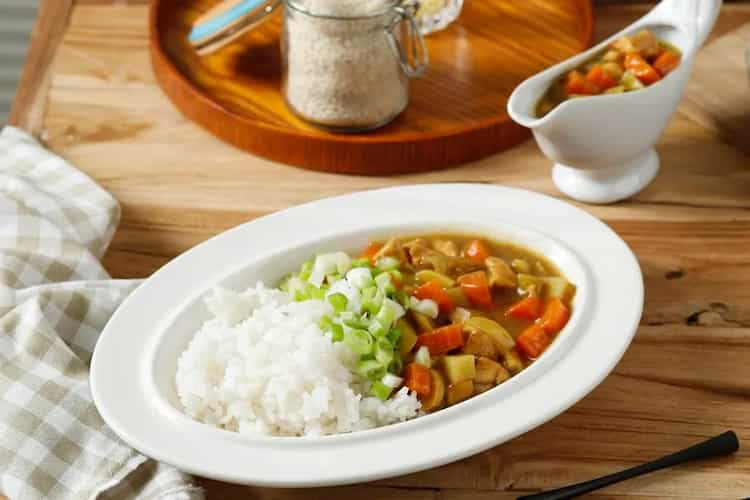You wouldn’t think it if you never visited Japan, but curry and rice is among the most popular dishes in the country. Kare (for the right pronunciation, change (cur-ry to "cur-A") is the Japanese name for curry. And Raisu ("rice-ooh") is, well, rice. Kare Raisu is Japanese curry and rice, and it has been adapted to local tastes. And what a wonderful flavor it has.
Japanese families make it at home, and kids grow up with this dish as a childhood staple. It’s made using curry blocks available for sale at stores across the land, though it is also available in curry powder form. Kare has been in Japan since the mid-1800s during the Meiji period, when the British brought it over. Kare Raisu is a thick curry sauce served with vegetables and meat (usually beef or chicken) and is influenced by British and Indian cuisines. But, like most things Japanese, it has taken on a wonderful form of its own and flourished. Kare is sweeter than Indian curry, and the gravy is thicker, almost glutinous.
The Japanese navy and most of the region were facing a number of cases of beriberi, a medical condition where lack of vitamin B1 (thiamine) causes problems in the nerves and could lead to paralysis or even death if left untreated. In the Meiji era and right up to the early 1900s, it was a feared disease. A Japanese naval officer, Kanehiro Takaki, showed that beriberi was caused by thiamine deficiency. Around the same time, "British traders and travelers wanted an easy way to recreate Indian-style dishes, resulting in the popularity of mulligatawny and country captain, as well as a booming industry in pre-made, all-purpose curry powder." Curry, at the time, was an all-encompassing term for a spicy dish with a thick gravy or sauce. When the Brits reached Japan, so did the curry.

The timing couldn’t be better for curry’s growth: Meiji-era Japan saw an institutional shift in attitude as Japan’s wider culture shed its inward-looking older self and embraced the new. We also know this era as the Meiji Restoration, which allowed Japan to draw on tradition as well as modernity to forge a new nation.
A modern army was raised as the nation shed its feudal traditions and militarized in a modern way. Japan needed to feed its new and growing army in a healthy manner. The older methods of feeding lots of white rice weren't efficient enough: removing the outer layers from white rice removed the thiamine content in the rice. That meant beriberi (kakkein Japanese), which had killed everyone from royals to shoguns to commoners, was always a lurking danger. In keeping with the open spirit of the time, Takaki had studied medicine in London and brought new methods of research to Japan. He is said to have emotionally blackmailed the emperor of Japan so as to continue his research: "If the cause of this condition is discovered by someone outside of Japan, it would be dishonorable."
He noticed that Western sailors didn’t suffer from beriberi, in particular the soldiers from Britain. What did the British sailors eat? Curry. But it was quite different from Indian curry—it had vegetables, beef, butter, and a sauce that was made thick using flour. Meat and flour are rich in thiamine, so beriberi was not a concern in the British Navy. Serve this British curry over rice, and Japan’s soldiers might just have a chance against the dreaded illness. And so, Anglo-Indian curry became Kare Raisu, a widely used food in the formative years of Japan.
The first Japanese recipe for curry, "raisukare," was published in 1872, just a few years after the Meiji era began. However, it wasn’t available to the larger local population. Curry had to be imported and was available only in expensive Western restaurants. In the 1920s, domestically manufactured curry mixes led to a drop in prices, and it wasn’t long before the civilian population succumbed to the charms of Kare. By the end of World War II, curry was a habit for Japan’s servicemen. By the 1950s, cubes of prepackaged curry sauce were being sold everywhere in Japan. People began making kareraisu at home with as many variations as possible. In the process, Japan also found a new "national dish" that was adapted to the Japanese palate and was even being served in school cafeterias. Some brands also sold curry blocks flavored with honey and apples!

The Japanese military was dissolved after World War II, but the successor defense force—the Japan Maritime Self-Defense Force—continued the curry tradition. Soon, the army also took to kare-raisu, and by the year 2000, kare-raisu had overtaken sushi and tempura in popularity. Today, its Friday menu has curry in it. According to some reports, "each JMSDF ship prides itself on having its own unique curry recipe." Yokosuka, a city on the Pacific coast of Japan just south of Tokyo, is the home of the U.S. Yokosuka Naval Base. The city hosts an annual Yokosuka Curry Festival, and the 2023 edition is slated for the second half of May.
The curry sauce is made using spices and a roux (a mixture of flour and fat used to thicken sauces) and has proved so popular that it has also been used in ramen, other noodle dishes and even fried rice. The vegetables usually added to kareraisu are onions, carrots and potatoes. Katsu Curry is the most popular version in Japan. It consists of pork or chicken cutlets mixed with curry sauce and rice. Sounds delicious, doesn’t it?


